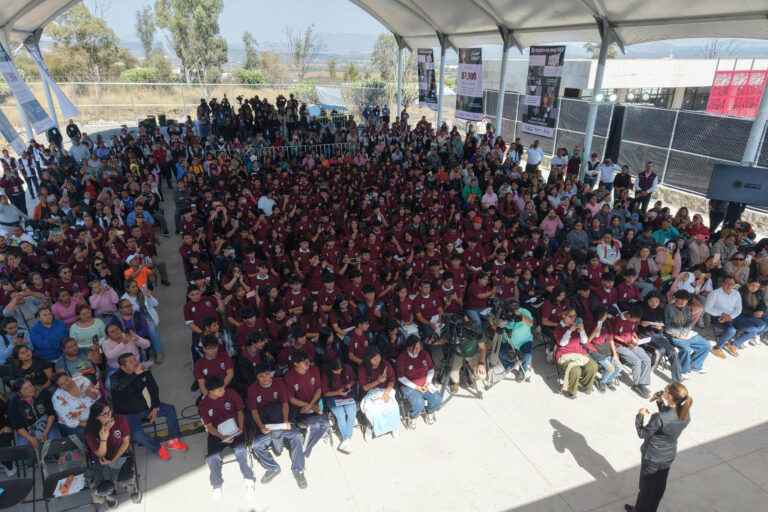NOT AGAINST A PARTY, AGAINST A MODEL
This editorial by Mauro Jarquín Ramírez appeared in the May 31, 2025 edition of La Jornada, Mexico’s premier leftist daily newspaper.
What are the CNTE’s Demands?
Immediate repeal of the 2007 ISSSTE Law; restoration of a solidarity-based, collective, and intergenerational pension system; the full recognition of retirement based on years of service (28 for women and 30 for men) instead of the age of 65; the payment of pensions based on the minimum wage rather than on UMAs; the elimination of AFOREs as a privatization model (AFOREs are private companies who manage pensions as individual accounts, extremely restrictive and profitable for finance capital: they were introduced in 1997 and based on the privatized pensions introduced by Chilean fascist Pinochet); and a profound restructuring of ISSSTE to restore its social character.
A father and son walk alongside the teachers’ protest in Mexico City’s Zócalo. The young man asks about the reasons for the mobilization, and the father replies: “They’re fighting, but we all win. Look, it says ISSSTE. The law they’re fighting against also affects me.”
This succinct explanation goes much deeper than the enormous amount of ink that communicators aligned with Obradorism [Editor’s note: a term for Morena supporters], business magnates, and the PRI-PAN have devoted to discussing the CNTE mobilizations in recent days, maintaining an approach in which every political process in our country is permanently reducible to the relationship between rulers and governed, or between the government and the opposition. From this perspective, politics exists solely in partisan electoral competition, the control of institutions, and the exercise of power within the state apparatus.
Worryingly, this reductionist approach has also taken root in Morena, a fact that can be seen in virtually any public intervention by its leaders, sympathetic communicators, or even in the “common sense” of its members. This represents, in advance, an open renunciation of a fundamental element of the political analysis of any leftist project: materialism.
That is, the analysis of the specific conditions under which the political process develops, the objective interests of those involved in said process, and, in particular, the class dynamics present in certain situations.

Given this rejection of a leftist epistemology, it’s not surprising that pro-4T commentators and those in the pay of big capital agree on the content of their messages. Both find it convenient not to address the class dimension in the pension debate: capital, because it shifts the discussion away from the essential issue of who gets to keep the socially produced wealth, and Obradorism because it allows it to circumscribe national problems within the false dichotomy between 4T and the partisan opposition, thereby gaining greater capacity to manage public debate.
In the current context of the teachers’ struggle to change the pension system, economic and political powers have once again united in a campaign against the CNTE. Thus, they have sought at all costs to prevent the working class affected by the 2007 ISSSTE law (workers in service to the State) from being addressed by the teachers’ mobilization. To this end, they have resorted to both a media campaign of discredit and the operation of corporate structures of union control.
In addition, there is a persistent exploitation of the fact that more than half of the country’s working class is in the informal sector (another legacy of neoliberalism), and therefore, any struggle for improvements in working conditions and pensions can be perceived as a pursuit of privileges.
In this context, it is essential to clarify that the current political situation is, strictly speaking, about class struggle. We are not talking about a mobilization of workers against a party, but against a model. A “neoliberal model” that has affected the vast majority of people for decades and that, although it was decreed “abolished” on March 17, 2019, by former President López Obrador, is still in good health.
The national teaching profession is thus leading a struggle to recover the wealth produced by labor, expropriated by capital with the support of neoliberal governments and the power of the state apparatus. As the father told his son, this is a struggle that concerns not only education workers, but its implications extend to other sectors of the workforce.
It’s true that the current context (national and global) is not easy for the Mexican government. There are pockets of resistance to change in various strategic areas of the state when the Obrador administration chooses to advance certain proposals that benefit the public interest. It’s also true that neoliberalism isn’t “just any old thing.” Overcoming it requires profound changes in regulation, political organization, and the balance of power.
Therefore, radically changing the pension system in Mexico is not a simple task either. Financial capital occupies a fundamental role in the development of business communities at the national and global levels, and it has real power to pressure governments when a policy threatens its interests.
However, it was under these conditions that both former President López Obrador and then-candidate Claudia Sheinbaum publicly committed to building a pension system favorable to workers. If they took this position while in office or when seeking popular support, it was because they knew such change was possible, strengthening the public sector rather than private interests.
The necessary path is one of frank dialogue. And with it, the search for solutions that strengthen the public sector, taking into account international experience and the proposals generated by the teaching profession itself. This requires publicly acknowledging that what is at stake is not the vulgar electoral back-and-forth, in which the 4T has sought to enclose all public discussion and which does so much damage to democracy, but the future of millions of workers who have dedicated their lives to serving Mexico.
Who Owns the AFORES?
There are 10 AFORES, that as of 2025 manage more than 7.18 trillion pesos (401 Billion USD). The AFORES system, modeled on Chilean fascist dictator Pinochet’s privatization of pensions, have been criticized by international pension industry observers for lacking sufficient oversight. The Mexican government has cited the complexity of the system as a reason not to de-privatize it, which begs the question, if the pensions are too complex to return to the public, how can they be meaningful overseen and regulated?
AFORES accounts are mandatory for every worker: they cannot withdraw from the system or manage the fund themselves or collectively with their union, such as with the Ontario Teachers’ Pension Plan, which manages over $188 billion USD).
1. AFORE Coppel – Coppel Group
2. AFORE Azteca – Grupo Salinas, owned by Ricardo Salinas Pliego, an ultra-right wing billionaire who is fighting in the courts to not pay the 35.450 billion pesos ($1.8 billion USD) in taxes he owes to the Mexican government.
3. Citibanamex Afore – Citigroup —in the process of being sold (USA)
4. Afore XXI-Banorte – Banorte
5. SURA – SURA Group (Colombia)
6. Profuturo – BAL Group (owners of the high-end department store El Palacio de Hierro)
7. Principal – Principal Financial Group (USA)
8. Invercap – Private investment fund
9. PensionISSSTE – The only public pension, limited to state workers
10. Inbursa – owned by Carlos Slim, one of the richest businessmen in the world, who recently advocated ending the public pension system and abolishing the retirement age in Mexico, and met with Claudia Sheinbaum this week.
-
The Poor as Instruments, Not Allies
Welfare programs with political aims are not the same as forging political alliances with the impoverished population created by voracious neoliberal capitalism.
-
Florida, the Race for the Presidency & Opaque Capital
Contemporary Florida is the distorted and advanced mirror of a new form of global governance, where money laundering has not only been tolerated, but institutionalized & updated for the digital age, fed by a murky river flowing from the Global South.
-
People’s Mañanera December 22
President Sheinbaum’s daily press conference, with comments on economic achievements, Sonora development plan, extortion of immigrants, Baja California Sur dam, water treaty with US, nepotism loopholes, and García Luna.




